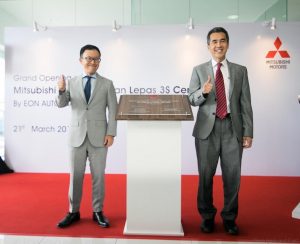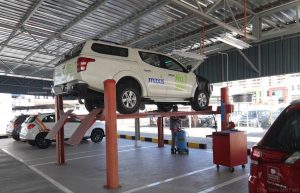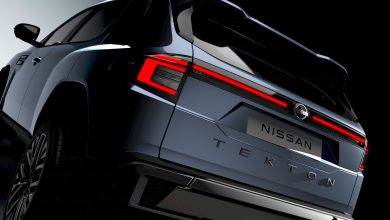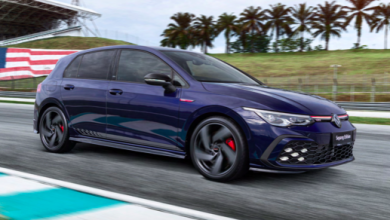மிட்சுபிஷி 3S மையம் பாயான் Lapas திறக்கப்பட்டது

யுகம் வாகன மார்ட் Sdn Bhd: (யுகம் வாகன மார்ட்), DRB-HICOM குழும நிறுவனங்களின் உறுப்பினராக, மற்றும் மிட்சுபிஷி மோட்டார்ஸ் மலேஷியா இன்று அதிகாரப்பூர்வமாக பாயான் லப்பாஸ் புதிய மிட்சுபிஷி 3S மையம் தொடங்கப்பட்டது. இந்த பாயான் லப்பாஸ் மற்றும் சுற்றியுள்ள மிட்சுபிஷி உரிமையாளர்கள் மற்றும் அதிக பினாங்கு பிராந்தியத்தில் மேல் மீதோ சேவைகளை வழங்கும் நிறுவனத்தின் முயற்சியின் ஒரு பகுதியாக உள்ளது.

செயல்பாட்டு டிசம்பர் 2016 முதல், பாயன் லப்பாஸ் 3S சென்டர் முன்பு புக்கிட் Mertajam அமைந்துள்ள மிட்சுபிஷியின் 3S மையத்தில் ஒரு இடமாற்றம், உள்ளது. மூலோபாய பினாங்கில் இலவச தொழில்துறை மண்டலம் மற்றும் 20 நிமிடங்கள் விட்டு ஜார்ஜ் டவுனில் இருந்து அமைந்துள்ள, பாயன் லப்பாஸ் 3S சென்டர், நல்ல வளர்ந்து வரும் வாடிக்கையாளர்கள் தேவைகளை பூர்த்தி செய்ய, அப்பகுதியிலிருந்த வளர்ந்து தொழில்துறை மண்டலம் பயன்படுத்தி மற்றும் புதிய குடியிருப்பு குடியிருப்புகளை எடுத்து எதிர்பார்க்கப்படுகிறது .

1,199 சதுர மீட்டர் மொத்தம் பில்ட் அப் நிலப்பரப்பை, மிட்சுபிஷி 3S மையம் ஆறு சேவை கடலும், ஒரு சலவை வளைகுடா மற்றும் ஒரு வரவேற்பு பகுதியில் உள்ளது. மேலும், மையத்தில் ஐந்து வாகனங்கள் மற்றும் ஒளி சாப்பாட்டில் வாடிக்கையாளர்கள் வசதிக்காக வழங்கப்படும் அங்கு, Wi-Fi, பொருத்தப்பட்ட ஒரு வாடிக்கையாளர் லவுஞ்ச் வெளிப்படுத்தவும் முடியும் என்று ஒரு ஷோரூம் கொண்டுள்ளது.

முழுமையாக மிட்சுபிஷி மோட்டார்ஸ் மலேஷியா மூலம் சான்றிதழ் கண்டறியும் கருவிகள் மற்றும் சிறப்பு கருவிகள் அமைக்கவும் (SST க்காக) பொருத்தப்பட்ட, சென்டர் மிகவும் பயிற்சி பெற்ற ஒரு 20-உறுப்பினர் குழு மூலம் மனிதர்கள் மற்றும் மிட்சுபிஷி சிறந்த பாதுகாப்பு வழங்க விற்பனை செய்பவர்கள், சேவை ஆலோசகர்கள், தொழில்நுட்ப மற்றும் நிபுணர்கள் பிறகு அனுபவம் உள்ளது பொது சேவை மற்றும் முக்கிய ரிப்பேர் உட்பட வாகனங்கள்.
புதிய 3S மையம் பெரும் திறப்பு திரு Tomoyuki Shinnishi, மிட்சுபிஷி மோட்டார்ஸ் மலேஷியா பிரதம நிறைவேற்று அதிகாரி மற்றும் Encik Rohime Shafie, தானியங்கி விநியோகத்துறை தலைவர் மற்றும் தயாரிப்பு மற்றும் பொறியியல் பிரிவு, DRB-HICOM பெர்ஹாட் அதிகாரப்பூர்வமானதாக்கப்பட்டது.
Rohime வாடிக்கையாளர் திருப்தி முக்கியத்துவத்தை இன்றய, மற்றும் வாடிக்கையாளர்கள் மிட்சுபிஷி பிராண்ட் தங்களின் முழு உரிமை அனுபவம் முழுவதும் மேல் தரமான சேவை தகுதியில்லை என்று நம்புகிறார்.
மிட்சுபிஷி பாயான் லப்பாஸ் 3S சென்டர் 5:45 மணி 8:30 இருந்து திங்கள் முதல் வெள்ளி வரை செயல்பட்டு, அதன் ஷோரூம் க்கான 5:00 மணி வரை 10:00 am வார இறுதி நாட்கள் மற்றும் பொது விடுமுறை. Aftersales சேவைகள் மட்டுமே திங்கள் முதல் காலை 8.30 இருந்து 5.30 சனிக்கிழமை கிடைக்கும், மற்றும் ஞாயிறு மற்றும் அரசாங்க விடுமுறை மூடப்பட்டது. மையத்தில் ஒரு 5km சுற்றளவில் மிட்சுபிஷி வாடிக்கையாளர்களுக்கு பயண சேவையை வழங்குகிறது.




